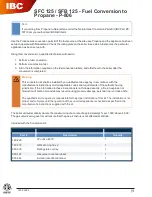
OM-NGB/3 5
Water Quality & Treatment
REDUCE SCALE PROBLEMS BY USING
AND MAINTAINING A WATER SOFTENER
FOR YOUR STEAMER!
It is essential to supply the steam generator with water that will not form scale or cause
corrosion. Even though the steam generator is engineered to minimize scale formation
and the effects of corrosion, their development depends on the quality of your water
and the number of hours per day you operate the equipment.
Most water supplies are full of minerals and chemicals which are not suitable for use in
a steam generator.
Water quality varies from state to state and city to city. It is necessary that you know
and understand the quality of the water you are using. Your water utility can tell you
about the minerals and chemicals in your water. The water going to the steam genera-
tor should be within these guidelines
Water Pressure
30-60 psi
PH
7
to
9
Hardness
less than 60 ppm
TDS
30 to 60 ppm
Chlorine and Chloramine
less than 0.1 ppm
Total Chloride
less than 30 ppm
Silica
less than 12 ppm
Undissolved Solids
less than 5 microns
1. Do not rely on unproven water treatments which are sold for scale prevention or
scale removal. They don’t always work. The best way to prevent scale is to supply
the purest possible water (30 - 60 ppm TDS).
2. If your water contains scale-forming minerals, as most water does, use a
well-maintained water softener. Whether an exchangeable softener cartridge or a
regenerating system is chosen, a regular exchange schedule is essential.
3. Installing a water meter between the softener and the steamer will provide an
accurate gauge of water use, and will help determine when to exchange cartridges
or regenerate the softener. Using a water softener will provide longer generator life,
higher steam capacity, and reduce maintenance requirements.
4. If you notice a slowdown in steam production, have the unit checked for scale
build-up. Heavy scale reduces the unit’s ability to boil water and can even cause
heating elements in the steam generator to overheat and burn out.






































